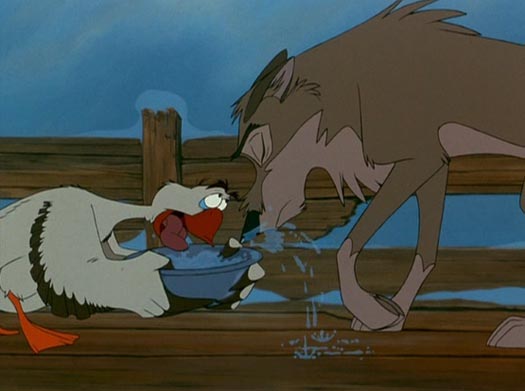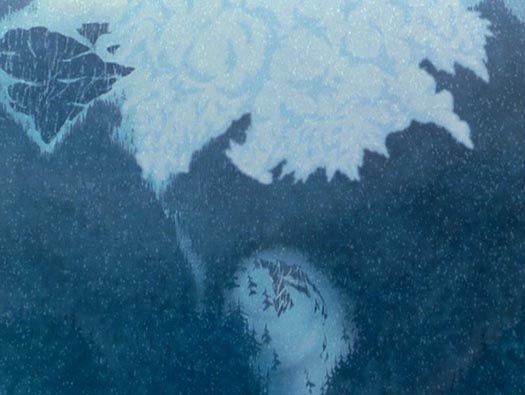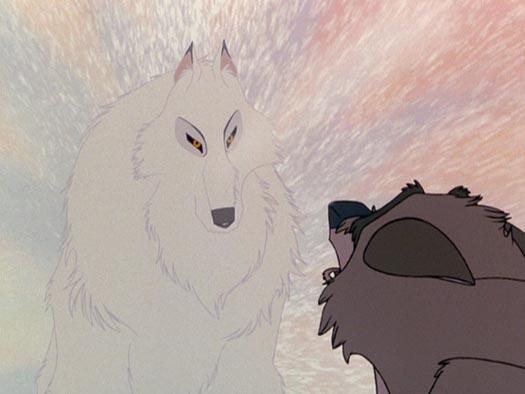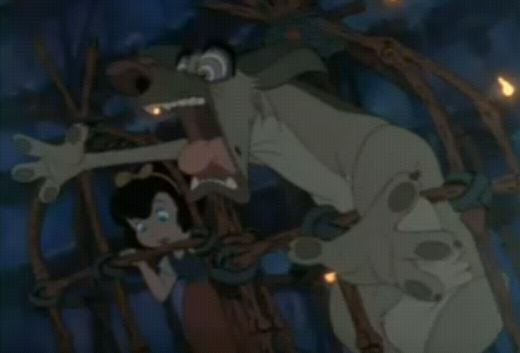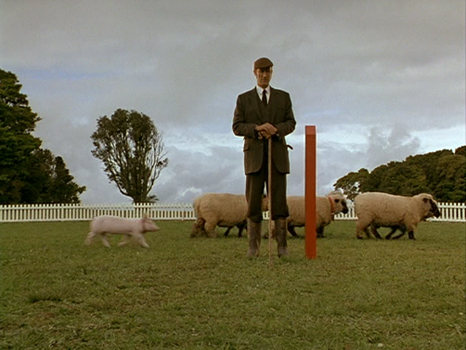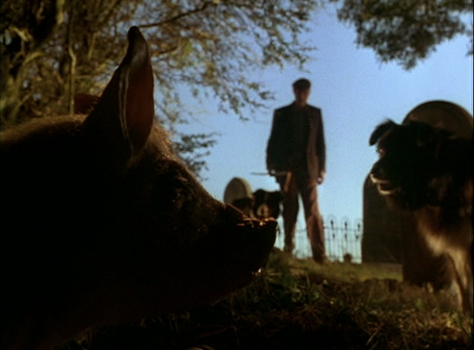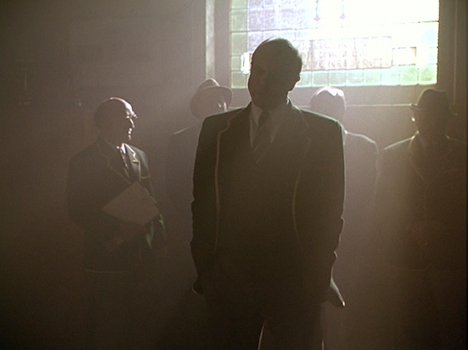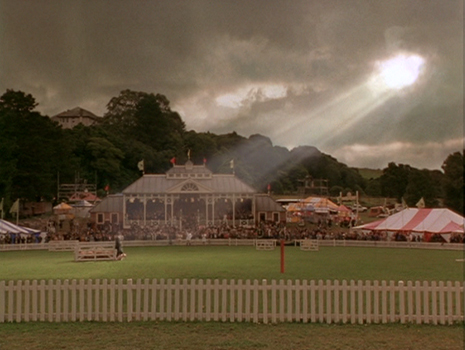Archive for category Childhood Revisited
CHILDHOOD REVISITED – BALTO
Posted by kjohnson1585 in Animation, Childhood Revisited, Film, Uncategorized on December 14, 2009
Balto– (1995)
Director: Simon Wells
Starring: Kevin Bacon, Bob Hoskins, Bridget Fonda, Jim Cummings
Screenplay by: David Steven Cohen, Elana Lesser, Cliff Ruby, Roger S.H. Schulman
Two weeks of animated canines; just like the past weeks of animated mice and the upcoming foray of animated cats (which will be revealed in time). It’s interesting to not only see how these animals are anthropomorphized, but also how different studios go about their different nuances in the process. Bluth focused on dogs being rebellious, gang/mafia-like scumbags and anti-heroes.; Amblin Entertainment, Spielberg’s animation studio prior to Dreamworks, took a different, Disney-like approach, of pure heroes finding themselves among one evil dog, one female dog, and a number of wacky characters.
The real story of Balto is both interesting and boring. There is a real “moment” of bravery when the canine sniffed out the correct trail while the sled-dog team was crossing some very thin ice. Of course, there’s other details; a dog named Togo ran the toughest, longest section of the relay, for example. All the details can be found here. The info is all over the place, though; IMDB needs a trivia editor, stat.
NOSTALGIC LENS: I had only seen this film once. Maybe twice. I never really had much attraction or enjoyment of the film. It seemed generic, before I even knew what generic meant. Perhaps there’s some subtly that I missed when I was younger that will be a bit more apparent on review.
DOES IT HOLD UP: Meh. Balto is among so many specific-of-its-time 90s films where its conventions and clichés are obvious and apparent. Hell, it’s even book-ended with live-action. Mostly everything and everyone is predictable. And yet, in the 90s, the art of telling the story, no matter how familiar, was so well-defined and refined, that seeing the same general plot rehashed in a different light in little to no way affect the actual enjoyment of the film.
Balto is a half-wolf, half-dog (I think husky but the film never makes it clear) stray who dreams of racing with the actual champion sled-dogs of Nome, Alaska. But his wolf side puts fears and doubts into the humans’ mindset. In addition, Steele, the evil sled dog leader who’s “losing a step,” sabotages every attempt Balto makes to gain their trust. This all happens during a diphtheria outbreak. In the middle of a blizzard, of course.
One of the more awkward issues with a story like this, especially from a writer’s standpoint, is how to rectify the hero’s passion for the “girl” – in this case, a domestic husky named Jenna – and the more grounded necessity to save the day – in this case now, a human girl named Rosie, afflicted with the disease. It comes off that Balto’s desire to get the medicine is less about the outbreak and more about “tappin’ that”. It’s interesting to see how films work that angle. I can’t say this film achieves it one hundred percent, but it does it better than most, especially via the moments when Balto “finds himself”.
The animation is passable; it has a harsh edge to it, which makes the character models kind of boring but really reflects the cold, hard tundra the characters are up against. It’s a nice-looking film, but certainly nothing to sing home about. The voice work is passable; I love this era, when many believed that celebrities could somehow instill their screen-charisma with their voices. Unfortunately, good acting does not equate to good voice work; Kevin Bacon (Balto) and Bridget Fonda (Jenna) do okay, but Jim Cummings as Steele, well, steals the show by strength alone. Cummings has always been one of my favorite voice artists (Billy West is the most talented, but Cummings has a lot of energy, especially as evil characters.) I wish they gave him better dialogue.
The plot follows the usual beats and runs the gamut of wacky moments and intriguing action. Humor is derived from Boris the goose, Muk and Luk (a couple of retarded polar bears), and the sled-dogs. (The raspy-voiced one is actually the best of the entire cast – something about him is very entertaining.) There’s a bear fight. A river breaks apart. Balto and Steele have a “fight”. Nothing new here. In fact, the climax race home is audacious to the point of being silly with the sheer number of “shit” that just happens to make things worse and worse.
Youtube lacks any useful videos, again, so I’ll drop some pictures.
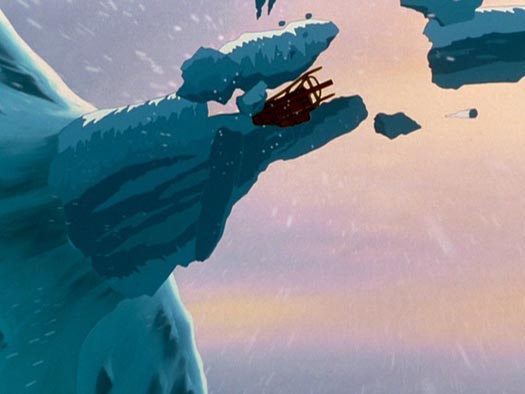
Dangerous, narrow ice bridge that breaks apart when crossing? Check.
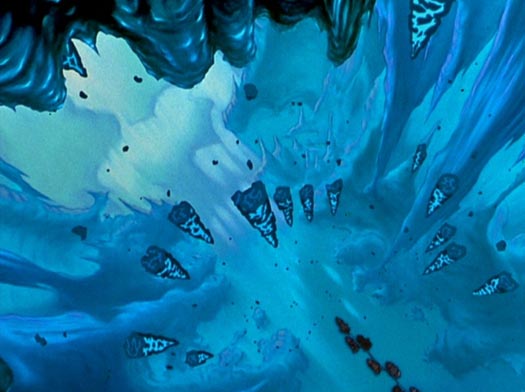
Cave with falling stalactites? Check.
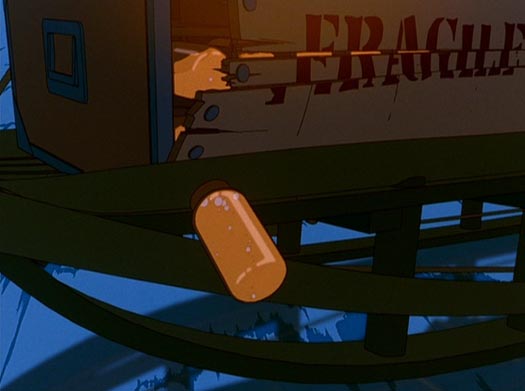
Medicine threatening to fall and shatter? Check.
Only thing that’s missing is a pseudo-vision quest.
Never mind.
IN A NUTSHELL: Balto is pretty decent. Nothing too exciting or mind-blowing, but not boring or mediocre, either. It’s pretty much everything you expect it to be. Yeah, I don’t have any else to say here. I’m going to make me a sandwich.
December 21st: A Goofy Movie
December 28th: A Charlie Brown Christmas
CHILDHOOD REVISITED – ALL DOGS GO TO HEAVEN
Posted by kjohnson1585 in Animation, Childhood Revisited, Film, Uncategorized on December 7, 2009
All Dogs Go to Heaven – (1989)
Director: Don Bluth
Starring: Burt Reynolds, Dom DeLuise, Vic Tayback, Charles Nelson Reilly
Screenplay by: David N. Weiss
We’re back on Bluth now, and you’ve probably noticed that I’m sort of jumping around on his Filmography. There’s no order to any of these films as I write up this feature, and certainly not to Bluth’s record, although, in retrospect, I should have at least approached these films in temporal order, to really see how his movies developed over time. Of the ones I did re-watch, I was knocked back and forth between really liking it and being overly disappointed. I’ll say this about the man – you never have any idea what you’re going to expect.
This was the first film Bluth made away from both Disney and Spielberg influences, relationships he was never too keen on. I certainly applaud the infamous animator for separating himself from the pack, but I can’t for say sure that it has always been for the creative best.
NOSTALGIC LENS: Vague. All Dogs Go to Heaven seemed like what I could only describe as “impossible to watch,” not because it was too graphic or hard for me to stomach, but more that it seemed too confusing, too complex. Nothing about the movie suggests an easy time for a casual viewer to “ease” himself into the story if he or she caught the film at some random point. Perhaps sitting down and simply watching it, from beginning to end, will make it all make sense?
DOES IT HOLD UP: No. It didn’t.
I… I don’t know what the hell I just watched. And let me tell you — I watch Spongebob Squarepants. I watch Aqua Teen Hunger Force, Squidbillies, Tim and Eric Awesome Show Great Job, and whatever else Adult Swim on Cartoon Network throws at me. I’ve seen the weird shit from the depths of Liquid Television and the mind-fuckery that can only be garnered from the foreign/independent animated studios the world over. And nothing, NOTHING could prepare me for the all-the-fuck-over the place spectacle of All Dogs Go to Heaven. I don’t know if the crazy writing or the bizarre animation confused me more.
After watching Secret of Nimh and then An American Tail, and in glancing at Bluth’s track record after this one, it’s as if the guy decided to slowly go crazy. Yes, you read that right – he didn’t go crazy, he decided to go crazy. And with this decision came an almost Dadaist visual and narrative incentive towards animated filmmaking, as if the filmmakers got high on drugs, and decided to make a family movie for families who also likes to get high on drugs.
Charlie Barker and Itchy escape from a dog pound (ie, prison) and return to their nesting grounds, which is just a casino for excessive gambling. “Partner” Carface, the double-crosser who set up Charlie in the first place, kills the canine with a runaway car. He goes to heaven, but returns on a watch-related loophole to seek revenge on Carface. He meets Anne-Marie, a lovable orphan who can talk to animals, and tries to use her against Carface, but he develops feelings for her instead.
Let’s get the good out the way first. I really dug the idea that different species of animals couldn’t communicate with each other and that they needed Anne-Marie to translate. It wasn’t forced fed, either. It was very deftly handled – at least until the infamous “Big-Lipped Alligator Moment,” which I will discuss later. Also, the characters were lively and spirited; never a dull moment when anyone was around.
Okay, I’m done there. What’s particularly odd here is that, after the relatively stable, quiet, calmer animation style of Land Before Time, Secret of NIMH, and An American Tail, Bluth and co. erupted an aggressive style of hyperized, ultra-stylistic movement. Characters rarely stay composed; there’s a constant push to keep them active. The editing doesn’t help much, either. Even the silent moments seem to be filled with activity, which makes it hard to keep a broad focus on the characters.
This could work, however, if it wasn’t for the story’s moment-to-moment beats. There are some intensely strange choices made, all at the expense of maintaining such animated hyperactivity. For example, Carface has some sort of fetish(?) of driving a fake car against a rotating paper background. He does this while angrily ranting about Charlie’s return to his goofy sidekick, Killer (voiced by – AHAHAHAHA!!! – Charles Nelson Reilly). While Carface’s rant to Killer makes sense, doing it during the fake car scene is completely baffling. What is that about? Couldn’t he have a simple, generic interoffice chat?
It keeps going with these insane moments, as if the writers (there were TEN of them working on the story) would use whatever idea someone spouted out, regardless of their state of mind – while the animators, who also had a questionable state of mind, took these ideas and just ran with it. I love how Carface and Killer manages to get hold of a tommy gun and BLAST Charlie full of holes, and somehow miss, and then somehow lose complete control of it. How about the ease to which the family accepts the orphan Anne-Marie into their homes? The ending has the typical “gather all the dogs and run to Charlie’s rescue” chase scene, which has absolutely no payoff. There’s so many ideas here, and it’s just so cobbled together, and the use of their transitions is just awful. (I mentioned this is An American Tail, but in All Dogs, it’s, to quote the notorious Christian Bale, fucking distracting.)
Nothing epitomizes the weirdness more than the scene which defined animation’s “Big Lipped Alligator” moment:
This happens, by the way, after they escape the shootout, and just happen to fall through a hole in their hiding place, whereby they are captured by voodoo mice (it’s New Orleans 1939, when the levees were still standing and voodoo was EVERYWHERE) to be sacrificed to this gator. And suddenly, singing. And while there is a bit of payoff to all this in the film’s climax, the music throughout is pretty awful. It’s not even good in the ironic way.
IN A NUTSHELL: As the Big-Lipped Alligator Moment occurred, I had to stop the film for a second to make sure I wasn’t going nuts. No, I wasn’t – it’s simply that All Dogs Go to Heaven is just insane, and not necessarily in a good way. It at the very least has a sad and somewhat rewarding ending, but the journey towards it is tolling. I have no issues with the dark nature of the content (death, gambling, poverty, etc.); I have reservation with the overall execution. It’s gonna be a few months of recovery before I take on Rock-A-Doodle.
December 14th: Balto
December 21st: A Goofy Movie
CHILDHOOD REVISITED – BABE
Posted by kjohnson1585 in Childhood Revisited, Film, Uncategorized on November 30, 2009
Babe – (1995)
Director: Chris Noonan
Starring: Christine Cavanaugh, Miriam Margolyes, James Cromwell, Hugo Weaving
Screenplay by: George Miller, Chris Noonan
The 90s were known for many things, not the least of all being the decade’s penchant for movies starring talking animals. The early decade simply had the animals “think-communicate”, kind of like telepathy (Milo and Otis, Homeward Bound, Look Who’s Talking Now). Babe was lucky enough to be release right when computer effects were just starting to be effectively realized, and yet not overbearingly so such that puppetry and animatronics were still being used. And, truth be told, if Babe, Jurassic Park, and Where the Wild Things Are are any indication, well, judicious use of animatronics plus judicious use of CGI is the perfect formula. Please take note, Mr. Cameron and Mr. Jackson.
NOSTALGIC LENS: Babe was a film that I remember loving, and even though I haven’t watched it in so long, I, for some reason, always stood up for it. I’m not sure why – lord knows there were plenty of lame and corny moments – singing mice, for instance – but yet, it was a sweet movie that seem to have always stuck with me, in some degree.
DOES IT HOLD UP: Babe is really a tricky movie to describe. I can only say this: Babe is, truly, a story. The characters are, truly, characters. Watching the film, no matter what happens, you’re always keenly aware that you’re watching a tale, a tale definitely derived from a children’s book. If I had to use one word, it would be endearing.
A lone, runt pig is taken from a slaughterhouse to be used as a “Guess The Weight” prize for a county fair. Farmer Arthur Hoggett wins the prize, the pig itself, and when it arrives on the farm, its loneliness catches the heart of sheepdog Fly, who takes care of it. There’s also a number of smaller stories and incidents, moments that seem like they could be pulled out from the film, but they, in oddly yet astute ways, drive the overall story, compelling Babe from a potential Christmas dinner into an amazing sheep herder.
Given the lack of Youtube videos out there (quality ones), I have to utilize screenshots, but I think that they point out one rather remarkable aspect: the cinematography. Andrew Lesnie brings a certain visual potency and poetry to many of the scenes, shots that are simultaneously amusing and powerful. They’re amusing in the sense that they divulge a weight on characters and moments that, at face value, are just goofy. But given the strength… no, better yet, given the film’s commitment to the story and the actors’ to the characters, they add to the ambiance of the film perfectly. It’s both silly and serious.
An interesting deep focus shot of Babe, Fly, Rex, and Farmer Hoggett after he runs away:
The hilarious evil glare over the Sheepdog committee condoning Hoggett and his “dog” named “Pig”:
The GOD light shone on Hoggett and Babe after winning it all:
It’s pretty funny, especially if you pay attention to the visuals. But, yet, it works.
“But, yet, it works” is essentially how viewers can swallow the lameness of some of the more sillier aspects. Of course, I mean the singing mice. (The high-pitched squeal singing voice will be, in a few years, used in a number of rap songs, and while I’m glad that’s over, I’d sure as hell would prefer that over the excessive vocoder use.) Part of why they work is because they’re rarely seen, and even when they’re present, they take up little screen time, enough not to become grating. It’s as if Noonan knew the supers (the inserts of the name of each “chapter”) would get too annoying, and they stop coming around the forty-minute mark. All the silliest moments are perfectly controlled; it’s as if Noonan wanted to emphasis the fact that, yes, the viewer is watching a story, and shouldn’t delve too much into it. And in case you do – BAM! You get a face full of singing mice. Deconstruct that shit.
The best aspect of the film are the human characters, hands down. Mrs. Hoggett (Magda Szubanski) steals the show as she exposits plot points so goofily, so energetically, it’s actually a treat to see her do it. Cromwell does grizzly-with-a-heart-of-gold so well. He always does, but he does it doubly so for this film. I love the oh-so-blunt line readings of the Hoggett’s children and grandchildren when they arrive, and the “pure evil” faces of the Sheepdog committee are gold. Hell, even the sheepdog crowd is great, with their overacted laughter transitioning to their overacted cheering. It’s so ridiculous, but amazingly pleasantly so.
Of course, the story is about Babe, and it’s enjoyable enough, if predictable. There’s a lot cute, humorous moments, as well as some surprisingly dark ones. And while all the characters having easy-to-see character arcs, they are still very worthwhile, especially when frustrated Kay finally warms up to the pig. It’s really nice stuff, very well handled.
And I know that Noonan didn’t want me to do this, but I couldn’t help but notice the not-so-subtly commentary of accepting stereotypical status quo mentalities, of pre-judging through racial (or, I guess, species) lenses. In the end, being nice, kind, and forward is all you need – although, I’m not sure what the “password” thing was all about. I assume it’s another one of Noonan’s and Miller’s ways to prevent me from reading too much into it.
Oops.
IN A NUTSHELL: Babe’s emphasis on its story and characters weaves a truly heart-warming tale that’s very easy on the eyes, mind, and soul. And while that sounds like what the back of the DVD case would say, it’s true. It’s a throwback film to a time when the storytelling aspect of the story was king, and any insane, crazy concept could be told with expect skill. And, if IMDB is correct, this film was a ten-year labor of love for George Miller.
It shows.
December 7th: All Dogs Go to Heaven
December 14th: Balto

